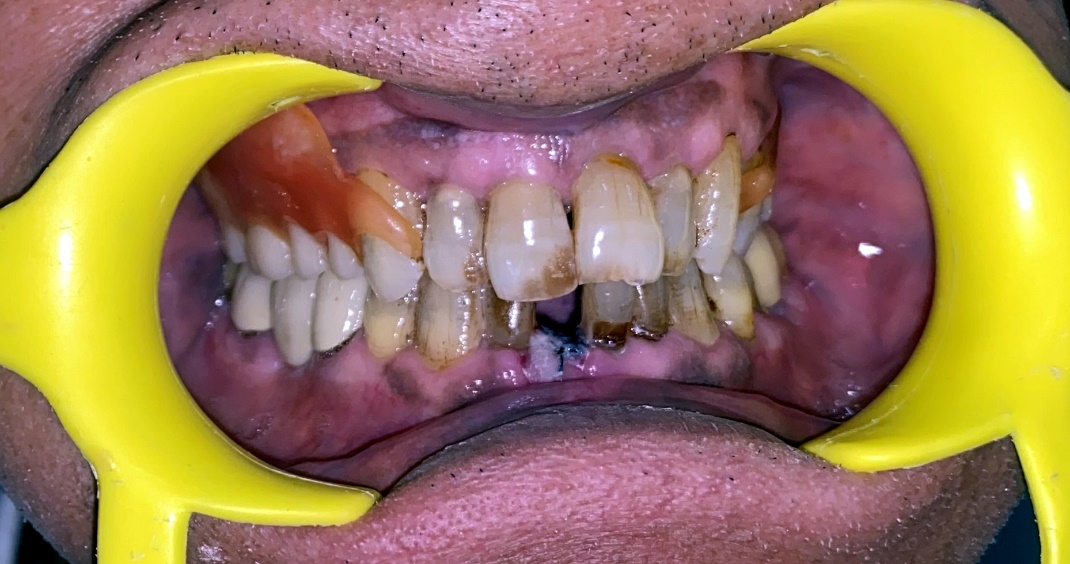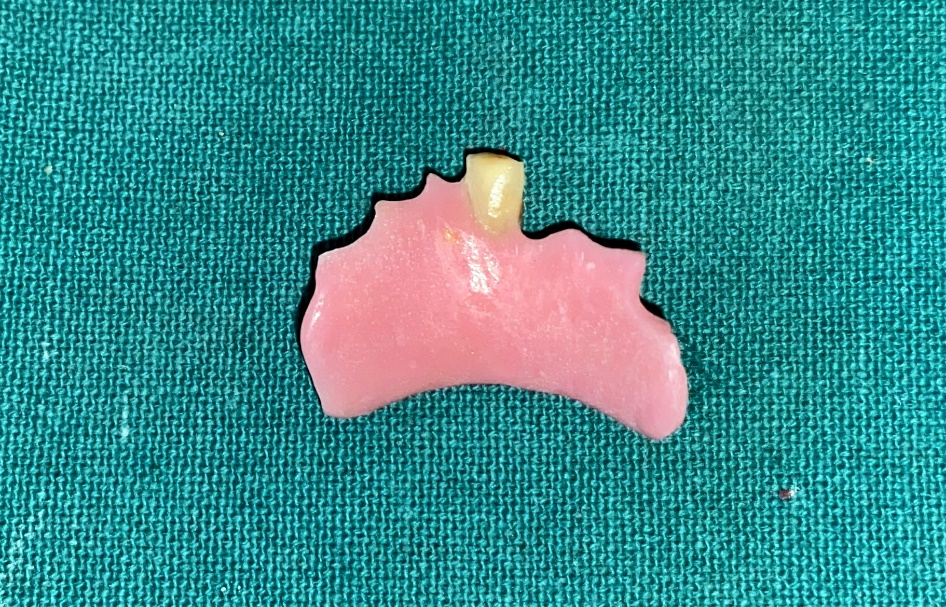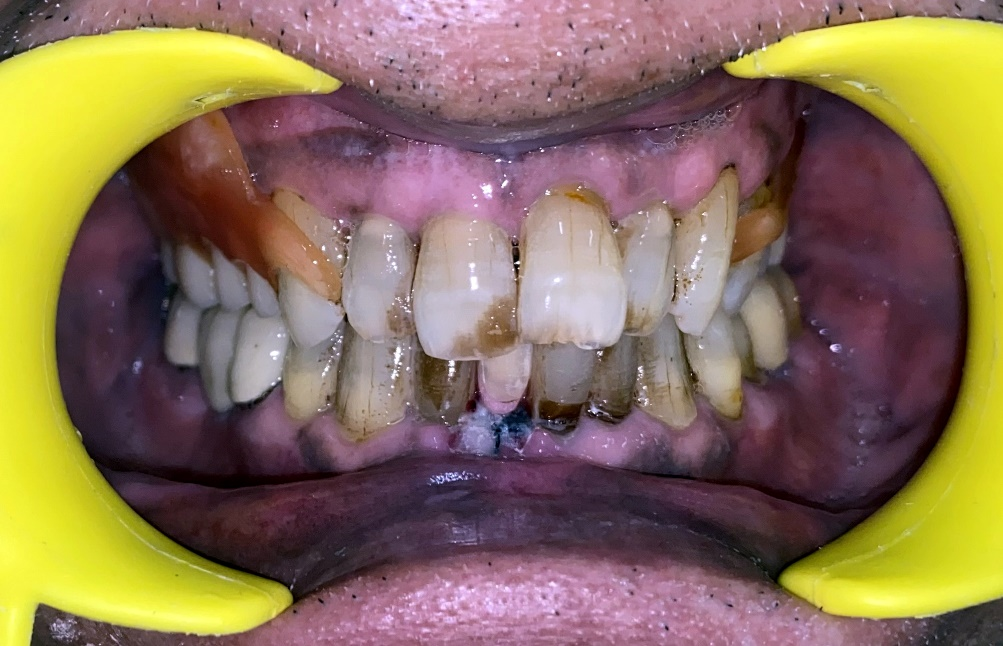Previous Issues Volume 7, Issue 2 - 2023
Immediate Partial Denture: Creating Seamless Aesthetics with Natural Tooth Pontics
Arpit Sikri1,*, Jyotsana Sikri2, Vritti Piplani3
1Department of Prosthodontics, Bhojia Dental College & Hospital, India
2Department of Conservative Dentistry & Endodontics, Bhojia Dental College & Hospital, India
3BDS intern, Bhojia Dental College & Hospital, India
*Corresponding Author: Arpit Sikri, Associate Professor & Post Graduate Teacher, Department of Prosthodontics, Crown & Bridge and Oral Implantology, Bhojia Dental College & Hospital, Budh (Baddi), Teh. Baddi, Distt. Solan, Himachal Pradesh, India, Tel: +91-7011836989, E-mail: [email protected].
Received Date: October 13, 2023
Published Date: October 23, 2023
Citation: Sikri A, et al. (2023). Immediate Partial Denture: Creating Seamless Aesthetics with Natural Tooth Pontics. Mathews J Dentistry. 7(2):40.
Copyrights: Sikri A, et al. © (2023).
ABSTRACT
For prosthodontists, replacing anterior teeth in cases of immediate partial dentures is a challenging undertaking. The difficulty is in getting the replacement tooth or teeth to match the natural tooth or teeth in terms of size, colour, tone, and shape. Working with patients who have high aesthetic standards is very demanding. According to its definition, an immediate denture is a removable dental prosthesis intended to be inserted right away after the extraction of a natural tooth or teeth. Patients who are losing their anterior teeth not only deal with aesthetic issues but also psychological effects. A tooth loss can cause a degree of functional loss, which may have an impact on one's oral health and overall quality of life. Anywhere between 1 to 16 teeth in the upper or lower arch, or both, can be replaced by immediate dentures. The need for immediate replacement is especially pronounced when dealing with missing anterior teeth due to their significant impact on aesthetics. Replacing an anterior tooth is a highly technique-sensitive process, as it involves meeting the patient's expectations for matching shade, shape, and size with their natural teeth. Mandibular anterior teeth play a crucial role in aesthetics, speech, smile, and self-esteem. While clinicians can restore missing teeth with artificial ones, the significance of natural teeth in shaping a patient's overall personality should not be underestimated. This article outlines a technique for crafting an immediate removable partial denture prosthesis using the patient's own natural tooth to replace a missing tooth, enhancing aesthetics and boosting patient confidence.
Keywords: Aesthetics, Extracted Teeth, Immediate Denture, Immediate Partial Denture, Natural Teeth.
INTRODUCTION
The smile, general aesthetics, and self-esteem of a person are all influenced by their mandibular central incisors, which are very important to physical appearance. Advances in restorative materials, including resin-based materials with tooth-colored fiber posts, placement techniques, conservative preparation designs, and adhesive protocols, have empowered clinicians to effectively repair fractured teeth [1]. Even when the original tooth fragment remains intact after a fracture, adhesive protocols can be employed to reattach it, ensuring reliable strength, durability, and esthetics. This approach is successful even for teeth fractured at the cervical margin [2].
Moreover, extracted anterior tooth crowns find utility as temporary restorations following implant surgery until a definitive prosthesis can be created [3]. Using the extracted tooth in this manner results in a highly biocompatible restoration that preserves the natural gingival contour and architecture in implant cases. Natural teeth also find application in prosthetic rehabilitation for partially edentulous patients [4].
An immediate denture is a complete or removable partial denture made to be inserted immediately following the extraction of natural teeth. Immediate dentures offer patients the advantage of maintaining their social and business activities without experiencing the discomfort of being completely edentulous, which can be embarrassing [5]. However, this advantage can be quite demanding and challenging because the selection of artificial teeth cannot be observed during the try-in appointment, and the patient must rely on the clinician's expertise. Nevertheless, by attaching the patient's own natural teeth to their immediate denture, the clinician can readily meet the patient's expectations, thereby enhancing their self-esteem and overall morale [6].
The present case report portrays the fabrication of an immediate removable partial denture that incorporates the patient's own natural teeth to improve esthetics and enhance the patient's comfort.
CASE REPORT
A 62-year-old male patient was referred to the Department of Prosthodontics due to complaints of mobility in his anterior tooth, specifically tooth-41. His history indicated that he had experienced trauma to this tooth a year ago, resulting in subluxation. Upon clinical examination, the tooth was found to be grade III mobile, and there was evidence of gingival inflammation. Radiographically, signs of internal root resorption were observed. Given the poor prognosis of the tooth, even after considering periodontal treatment, a treatment plan was formulated, involving the extraction of the affected tooth (Figure 1) followed by the creation of an immediate partial denture. This denture would incorporate the patient's own extracted natural tooth-41 to improve aesthetics.
Figure 1. Pre-operative view.
Before the extraction, impressions of the upper and lower arches were taken using irreversible hydrocolloid (Zelgan 2002, Dentsply India Pvt Ltd, Haryana, India), and casts were prepared using type III dental stone (Gyprock Dental Stone Plaster, Gyprock India, Gujrat, India). The affected tooth was then removed from the cast, and its edges were rounded to mimic an extracted socket. The tooth was extracted and thoroughly cleaned with saline. The tooth was then de-coronated, removing it to the level of the cemento-enamel junction. Any remaining pulp remnants were eliminated using hydrogen peroxide and sodium hypochlorite and disinfected with glutaraldehyde. Mechanical undercuts were created on the tissue surface of the decoronated tooth to ensure proper retention, as there wouldn't be a chemical bond between the extracted natural tooth and the denture base resin.
An immediate partial denture was then fabricated using the patient's own natural tooth (Figure 2).
Figure 2. Immediate Partial Denture.
After controlling bleeding and achieving initial clot formation, the finished and polished immediate partial denture was placed in position (Figure 3). The patient returned for a follow-up appointment after 24 hours for necessary adjustments and a checkup.
Figure 3. Post-operative view.
DISCUSSION
Advancements in the interim denture procedure over the past decade have been a noteworthy development in prosthodontic practice. Immediate dentures, in particular, have several advantages. They can help minimize changes in a patient's appearance that often occur when natural teeth are removed. Immediate dentures offer ongoing support, ensuring that the tongue, lips, and cheeks maintain their positions, allowing patients to engage in social activities without the discomfort of appearing edentulous [7]. This approach helps patients avoid the embarrassment of being in public without teeth. Crafting immediate partial dentures with a patient's own natural teeth is a practical and cost-effective technique, requiring minimal modification. It reduces the need for extensive laboratory work and materials, and the entire process can be completed in a single appointment. This method offers advantages such as fewer occlusal adjustments and excellent aesthetics [8].
Immediate dentures also serve as splints, aiding in the control of bleeding, promoting rapid healing, and protecting against trauma from the tongue, food, or opposing teeth. In some cases, anatomical variations may necessitate surgical alveoloplasty and reshaping of alveolar ridges for successful prosthesis placement. Disinfection with 10% glutaraldehyde and 5.25% sodium hypochlorite effectively reduces contamination and prevents future bacterial growth [9].
Concerns regarding the brittleness and strength of extracted natural teeth for long-term use can be addressed by utilizing the patient's old fixed partial denture (FPD) to fabricate an immediate denture, reducing the risk of brittleness and discoloration of natural teeth. This approach yields superior aesthetic results compared to prosthetic teeth, as porcelain and acrylic teeth offer a wide range of molds, shades, and customization possibilities [10].
While using natural teeth in partial dentures may seem like a step backward, it can significantly enhance aesthetics, especially in specific cases. The present technique described in the article, which has benefits over conventional removable partial dentures since it uses a patient's own natural teeth, can be used to create an immediate partial denture. In particular, mandibular anterior teeth play a crucial role in esthetics and speech [11]. Using the patient's own lower anterior teeth not only boosts their morale and self-esteem but also provides a sense of comfort, uniqueness, and improved esthetics. This conservative approach maintains the extracted teeth in their biological environment, enabling the patient to resume their routine social activities promptly [12].
A crucial consideration for such dentures is their proper maintenance, requiring them to be stored in water when not in use. The patient should be regularly recalled for follow-up appointments. Initial challenges in denture care may arise because natural teeth retain their shade and vital appearance when kept moist [13]. However, if they dry out, their appearance can change, but it typically returns when moisture is restored. In the case described, during the last visit, the removable denture was found to be in good condition, and the natural teeth retained their vital appearance. The longevity of such dentures can be extended through proper care, with no reported complaints of odors, taste issues, decay, breakage, or tooth loss [14,15].
The present technique is not recommended for posterior teeth because replacing their relatively large pulpal tissue with autopolymerizing resin would not withstand masticatory forces over the long term. Additionally, it's contraindicated for mouth breathers, bruxers (individuals with excessive teeth grinding), and patients with neuromuscular disorders due to potential issues related to dryness affecting the appearance of natural teeth and the limitations of acrylic resin under increased biting forces.
CONCLUSION
Immediate dentures are a viable option for patients facing the challenge of an edentulous state. They offer excellent aesthetics and patient satisfaction, making them an ideal short-term solution while allowing underlying soft tissue and bone to heal. Following this initial phase, a more definitive treatment plan, such as dental implants or fixed dental prostheses, can be considered.
Despite the many advantages of immediate dentures, there are limitations to be aware of. Patients typically require more frequent visits during the first few months to monitor changes in the oral cavity. Due to tissue changes after tooth extraction, immediate dentures often need to be refitted by a dental surgeon, typically within about six months, incurring additional costs. Furthermore, the original fit and occlusion of the denture may be compromised during the healing process. Proper follow-up care is crucial for the success of immediate dentures.
By following this approach, patients can avoid the social stigma of appearing without teeth, and they tend to be satisfied with the final results. The article also describes a technique that involves using natural lower anterior teeth for fabricating an immediate partial denture. Natural teeth retain their color and strength for a sufficient period, making them practical in certain situations. This conservative approach offers the added benefit of increasing patient compliance with denture wearing while enhancing aesthetics. It is particularly valuable for geriatric patients and cases where implant placement or other surgical interventions are not recommended.
FUNDING
None.
CONFLICTS OF INTEREST
The authors declare no conflict of interest.
DATA AVAILABILITY STATEMENT
The data presented in this study are available on request from the corresponding author.
REFERENCES
- Kretzschmar JL. (2001). The natural tooth pontic: A temporary solution for a difficult esthetic situation. J Am Dent Assoc. 132(11):1552-1553.
- Parolia A, Shenoy KM, Thomas MS, Mohan M. (2010). Use of a natural tooth crown as a pontic following cervical root fracture: A case report. Aust Endod J. 36(1):35-38.
- Stoller NH, Green PA. (1981). A comparison of a composite restorative material and wire ligation as methods of stabilizing excessively mobile mandibular anterior teeth. J Periodontal. 52(8):451-454.
- Al-Omiri MK, Karasneh JA, Lynch E, Lamey PJ, Clifford TJ. (2009). Impacts of missing upper anterior teeth on daily living. Int Dent J. 59(3):127-132.
- Avinash S, Jagadish S. (2007). Natural tooth pontic—a case report. Endodontology. 19:17-18.
- Purra AR, Mushtaq M. (2013). Aesthetic replacement of an anterior tooth using the natural tooth as a pontic; an innovative technique. Saudi Dent J. 25(3):125-128.
- Stein RS. (1966). Pontic-residual ridge relationship: a research report. J Prosthet Dent. 16(2):251-285.
- Prichard JF. (1972). Advanced periodontal disease: surgical and prosthetic management. 2nd edn. Philadelphia, USA: W.B. Saunders Company.
- Weintraub GS. (1989). Provisional removable partial and complete prostheses. Dent Clin North Am. 33(3):399-421.
- Ettinger RL. (1975). The etiology of inflammatory papillary hyperplasia. J Prosthet Dent. 34(3):254-261.
- Christensen LC, Koudelka BM, Norlind G. (1986). The immediate provisional fixed partial denture. Clin Prev Dent. 8(1):23-26.
- Portera JJ. (1981). Immediate fixed temporization utilizing extracted natural dentition. J Prosthet Dent. 45(3):286-288.
- Goodacre CJ, Bernal G, Rungcharassaeng K, Kan JY. (2003). Clinical complications in fixed prosthodontics. J Prosthet Dent. 90(1):31-41.
- Strassler H. (2007). Single visit natural tooth pontic bridge with fiber reinforcement ribbon. Tex Dent J. 124(1):110-113.
- Ţălu Ş, Alb SF, Pârvu AE, Dudea D, Lainović T, Gasparik C, Alb C. (2016). Factors influencing the choice of dental material and procedure for crown restoration of posterior teeth – design of a “decision guide. HVM Bioflux. 8(3):141-147.


